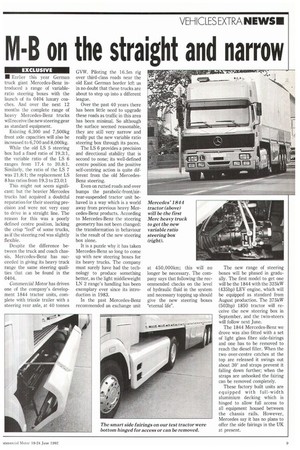M-B on the straight and narrow
Page 11

If you've noticed an error in this article please click here to report it so we can fix it.
• Earlier this year German truck giant Mercedes-Benz introduced a range of variableratio steering boxes with the launch of its 0404 luxury coaches. And over the next 12 months the complete range of heavy Mercedes-Benz trucks will receive the new steering gear as standard equipment.
Existing 6,300 and 7,500kg front axle capacities will also be increased to 6,700 and 8,000kg.
While the old LS 5 steering box had a fixed ratio of 19.3:1, the variable ratio of the LS 6 ranges from 17.4 to 20.8:1. Similarly, the ratio of the LS 7 was 21.8:1; the replacement LS 8 has ratios from 19.3 to 23.0:1 This might not seem significant: but the heavier Mercedes trucks had acquired a doubtful reputation for their steering precision and were not very easy to drive in a straight line. The reason for this was a poorly defined centre position, lacking the crisp "feel" of some trucks, as if the steering rod was slightly flexible.
Despite the difference between the truck and coach chassis, Mercedes-Benz has succeeded in giving its heavy truck range the same steering qualities that can be found in the 0404.
Commercial Motor has driven one of the company's development 1844 tractor units, complete with triaxle trailer with a steering rear axle, at 40 tonnes
GVW. Piloting the 16.5m rig over third-class roads near the old East German border left us in no doubt that these trucks are about to step up into a different league.
Over the past 40 years there has been little need to upgrade these roads as traffic in this area has been minimal. So although the surface seemed reasonable, they are still very narrow and really put the new variable ratio steering box through its paces.
The LS 6 provides a precision and directional stability that is second to none; its well-defined centre position and the positive self-centring action is quite different from the old MercedesBenz steering.
Even on rutted roads and over bumps the parabolic-front/airrear-suspended tractor unit behaved in a way which is a world away from previous heavy Mercedes-Benz products. According to Mercedes-Benz the steering geometry has not been changed: the transformation in behaviour is the result of the new steering box alone.
It is a puzzle why it has taken Mercedes-Benz so long to come up with new steering boxes for its heavy trucks. The company must surely have had the technology to produce something better, as the light middleweight LN 2 range's handling has been exemplary ever since its introduction in 1983.
In the past Mercedes-Benz recommended an exchange unit at 450,000km; this will no longer be necessary. The company says that following the recommended checks on the level of hydraulic fluid in the system and necessary topping up should give the new steering boxes "eternal life". The new range of steering boxes will be phased in gradually. The first model to get one will be the 1844 with the 325kW (435hp) LEV engine, which will be equipped as standard from August production. The 375kW (503hp) 1850 tractor will receive the new steering box in September, and the twin-steers will follow next June.
The 1844 Mercedes-Benz we drove was also fitted with a set of light glass fibre side-fairings and one has to be removed to reach the diesel filler. When the two over-centre catches at the top are released it swings out about 30° and straps prevent it falling down further; when the straps are unhooked the fairing can be removed completely.
These factory built units are equipped with full-width aluminium decking which is hinged to allow full access to all equipment housed between the chassis rails. However, Mercedes say it has no plans to offer the side fairings in the UK at present.




















































































